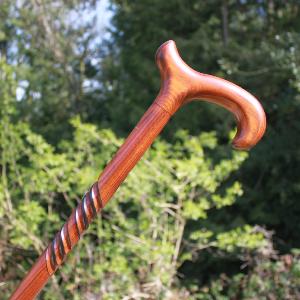 There are an astonishing 30 stages in the production of a typical Classic Canes beech derby cane, not including sales and marketing. If you have ever looked at a simple wooden derby walking stick and wondered why it costs £30 at retail, please read on. You will be amazed that it is not £130 when you appreciate all the work, investment and craftsmanship that has gone into its production. There are an astonishing 30 stages in the production of a typical Classic Canes beech derby cane, not including sales and marketing. If you have ever looked at a simple wooden derby walking stick and wondered why it costs £30 at retail, please read on. You will be amazed that it is not £130 when you appreciate all the work, investment and craftsmanship that has gone into its production.
First grow your tree (stage 1). This is probably the most difficult part and certainly the most time-consuming. Sawn timber for beech derbys is supplied by European beech trees of approximately 150 years of age. They are grown as commercial crops and new trees are planted to become the timber of 150 years from now. This is when you need your great-grandparents to have thought ahead. The felled tree (2) has to be transported to the roadside and then on to a speciality sawmill (3, 4), where it is planked (5), steamed for 10 to 15 days (6) and kiln dried (7). Beech wood has short fibres, which are not elastic once the wood is dried. Steaming improves the usefulness of the wood, changes its colour and makes it stronger, softer and easier to work on machines.
Having been transported to the factory (8), the craftsmen cut the wood into small pieces to make walking stick handles and into square batons to make shafts (9). The batons are machined into tapered shafts (10), and re-straightened if necessary (11). They are then sanded two to three times (12). The handle size blocks are planed (13) to bring them to the correct size for the handle being made, and then cut into approximate shapes using a band saw (14). They are put through a milling machine (15) to cut out the handle shape and are then hand sanded (16) before a hole is drilled in the handle (17) so that it can later be fitted to the shaft.
The top end of the shaft is machined so that it will fit into the handle (18). Strong glue is applied (19) and the handle is compressed onto the shaft (20). The join between shaft and handle is then polished until it is smooth (21).
The blank walking stick may then have a decoration such as a spiral carving applied (22). Carving the spiral itself involves six processes: three carvings of the inter-related spirals and then three polishings of the carved areas. The spiral is then scorched by hand (23); an extremely skilled job that requires many years of practice and a very steady hand. I have tried to do it myself and a horrible, burnt disaster quickly resulted.
The stick is then taken to the varnishing room, where three coats of highly-specialised varnish are applied: the filler coat, to smooth out any imperfections, which takes 3 hours to dry (24), the second coat (25) and the top coat (26). The top coats will take one to two nights to dry, depending on the weather, especially temperature and humidity levels.
The stick is then cut to the appropriate length (27), and the end is machined (28) ready to receive the metal or rubber ferrule (29). It is stamped with the company logo (30), packed and despatched. The finished stick, perhaps deceptively simple, has passed through many pairs of hands during its production. That it can retail for £30 means an exceptionally high-quality accessory is available for a surprisingly small amount of money.
There are of course short cuts that can be taken to reduce prices and so you will find inferior examples on the market. They may perform the same function, but the important details that make the stick safe, durable or aesthetically-pleasing all cost money. Cheap sticks are always cheap for a reason and are often the most expensive buy in the long run.
Wooden walking sticks have a charm about them that means they often become treasured companions of their users. The knocks and scrapes they take over their lifetime of use give them character; the patina of age is hard won. Some of course are the antiques of the future. Many a person has been touched to inherit a stick or collection of sticks from a grandparent; often this is the starting point for a collection of their own.
Charlotte Gillan
Managing Director
Classic Canes
|



